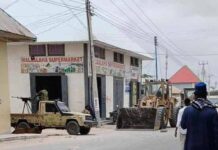MOGADISHU (Somaliguardian) – After a week of intense fighting and airstrikes, Somali government forces—bolstered by Ugandan African Union peacekeepers—seized control of the key agricultural town of Sabiid located roughly 40 kilometers south of Mogadishu.
The victory marks a significant step in securing the capital’s outskirts from Al-Shabaab insurgents, who had captured the area in a recent offensive.
The town, situated near Afgoye, a vital corridor to Mogadishu, fell to Al-Shabaab late in March as part of a broader militant push that saw them seize large swaths of territory in Hiran, Lower Shabelle, and Middle Shabelle regions. Its recapture is a tactical win for Somali forces, who have struggled to hold ground against the group’s persistent guerrilla tactics.
A Strategic Lifeline Secured
At the heart of the battle was a critical river-crossing bridge in Sabiid, a crucial link between Mogadishu and southern Somalia. By taking control of this route, government forces can now better restrict Al-Shabaab’s movements, cutting off a potential supply line for explosives and fighters into the capital.
Yet, the fight is far from over. Nearby towns like Awdhegle and Barire, which also command strategic river crossings, remain in militant hands. It is unclear whether Somali troops will push forward or consolidate their gains—a dilemma that has plagued past operations.
The Challenge of Holding Ground
Despite the victory, history casts a shadow over the achievement. Over the past decade, Somalia’s military has repeatedly retaken towns from Al-Shabaab, only to lose them again when militants regroup. In some cases, insurgents have even reclaimed territory shortly after troops establish bases, exploiting gaps in security and local governance.
Contact us: info@somaliguardian.com












